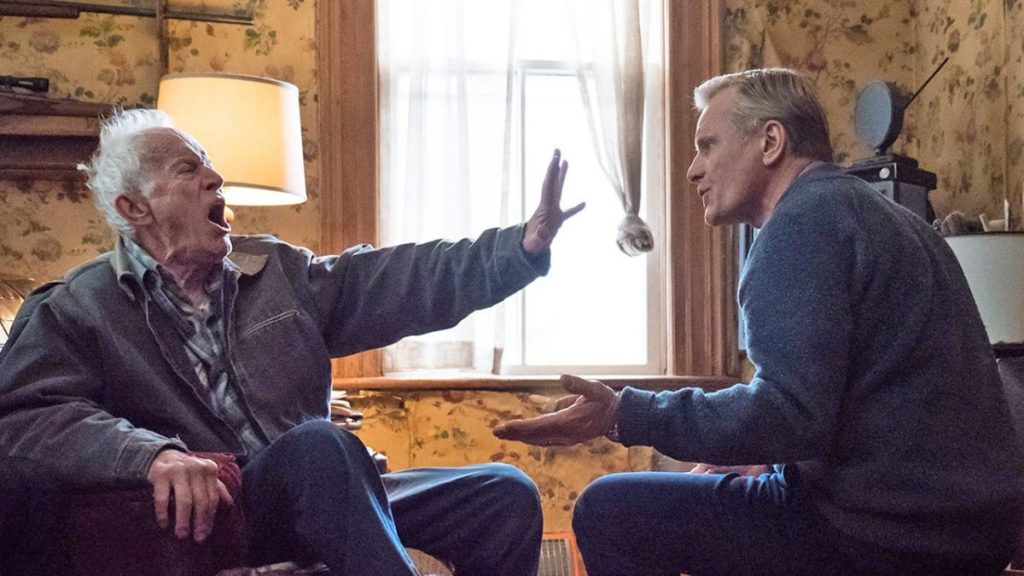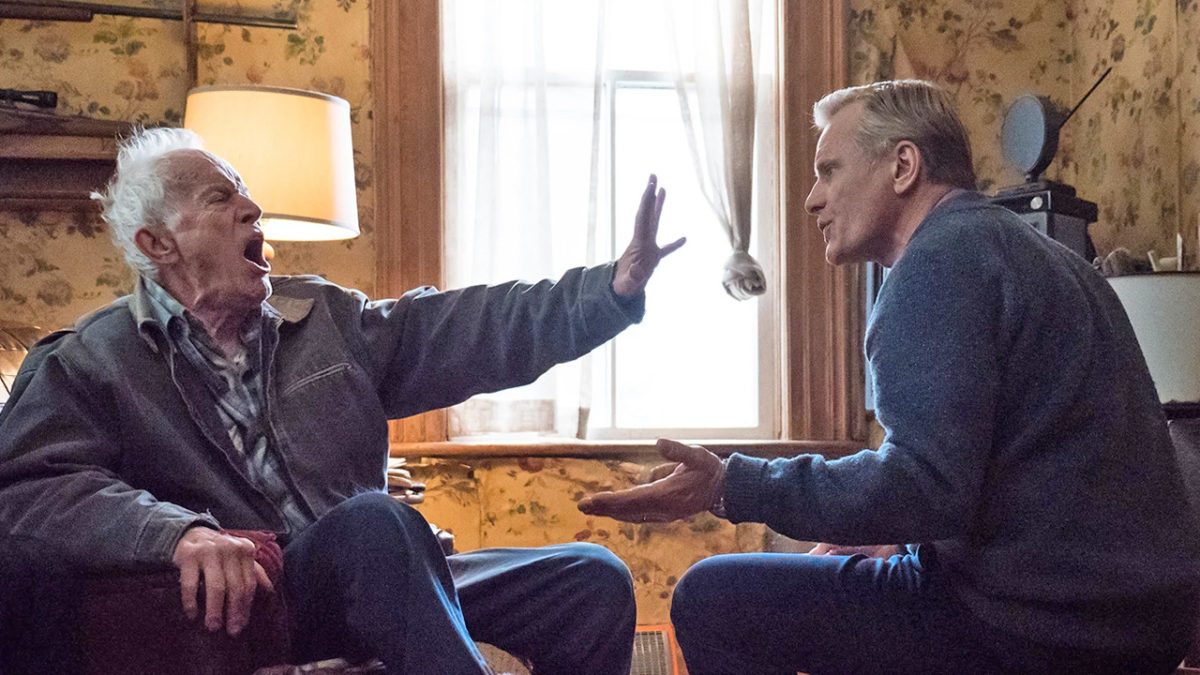
Viggo Mortensen directing his writing/directing debut film, “Falling.” Credit: Percival Pictures.
Falling is a beautiful film about a son’s experience growing up with an overbearing, often cruel, sometimes amiable father who is now aging and starting to fall into dementia. Anyone who’s ever cared for a parent suffering a similar fate will recognize the painful look on John (Viggo Mortensen) and Sarah’s (Laura Linney) faces when their father Willis (Lance Henriksen), confuses their mother with Willis’s second wife. It’s a heartbreaking moment.
This film marks Mortensen’s screenwriting and directing debut and, while it is a deeply personal story, isn’t exactly a true story. But Mortensen dedicates the film to his two brothers, making me suspect it’s truer than he’d like to admit. Either way, there is a poetic, visual rhythm that is thoroughly intimate and engrossing.
The film starts with John (Mortensen) picking up his father Willis (Henriksen) from his farm and flying him to California in hopes of relocating Willis near John’s home, where he lives with his husband and daughter. It’s a good plan only to be undone by a difficult man with an equally difficult disease. All the exposition is told through John’s memory in flashbacks and feels so authentic, they appear like a family photo album from the 1960s with faded reds and blues, images of a family that’s started to dissolve over time. I was able to Zoom with Mortensen who’s currently in Spain about his emotionally powerful film and his writing process.
The first time Mortensen tried to write and direct a film was about 25 years ago. “I’ve written several screenplays and tried to get them made into movies, but until Falling, I was not able to accomplish that,” he says, adding, “[The screenplay for] Falling took me a few goes, but that’s a common thing in independent movies. They often tend to be unorthodox in their structure and they tend not to resolve in some predictable way. At their best, they tend to put an emphasis on realistic relationships and behavior and that’s not usually predictable and can’t be put into neat little boxes.”
He says that as a movie-goer, he doesn’t like watching films that tell him how he should feel. “I like stories that, by virtue of the storytelling, the screenplay, the visual presentation, whatever combination of those elements are – if in the first 10, 15 minutes I’m interested, I’ll go with you. I’ll enjoy filling in the blanks, and in a sense, participate in the telling of the story so that the movie becomes as much my movie as yours. So I made the kind of movie I like to go see.”
Though passionate about writing, like most writers, Mortensen has good days and bad.
“Sometimes it really flows. When it flows and you have some good ideas, the dialogue is coming easily and the structure is coming together, it’s the easiest, most enjoyable thing you can occupy your time with. But when you come up against a wall, or you’re thinking, ‘I’ve got to go back 20 pages and redo all of that now.’ That can be grunt work and frustrating.”
When that happens, he says it helps him to step away from the computer, go for a walk or watch a movie.
He also says the rewriting process can be just as difficult. We’ve all had the experience of thinking a screenplay is really great, but then rereading it and realizing it’s not. “Sometimes, it ends up being not as bad as you think it is. Suddenly, you eliminate one piece, or you eliminate one bit of dialogue or give it to another character, it’s suddenly like, ‘Oh, now it works! It’s not as bad as I thought.’ It’s a process. And the process making Falling continued to the very end.”
When it came to the structuring the script and weaving the flashbacks through the story, Mortensen says he worked very hard to put those scenes in the exact right place. “I wanted the structure to have a certain rhythm and pace from act one to two to three. And the half-way point – what change needs to happen now and where do these scenes fit into the sequence? I played with that a lot.”
He says those flashbacks got moved a bit during the film editing process, but ended up pretty close to where they were in the screenplay. He likens editing the photography to editing music, which he has a lot of experience with. “I’ve been editing, mixing, mastering music for years and you have to listen to it a lot. Just like you have to watch the images a lot. You have to go over and over it, just like you’ve gone over and over your screenplay to get rid of extraneous things, loose ends, making sure it’s structured the way you want it to be.”
In the end, he says it’s really about the rhythm. “Is it, ‘Boom… boom… boom?’ Or is it, ‘Boom/boom/boom?’ Or maybe it’s just, ‘Boom!’ and you go to something else, or maybe you don’t even need that note. It’s similar in the writing. It’s all about rhythm and tempo and timing, and then you just hope you’re blessed with really good actors, that are essentially good musicians to play the composition you’ve come up with and for a movie – that’s the screenplay.”
One scene I couldn’t resist asking Mortensen about is the scene where film director/actor David Cronenberg (who’s directed Mortensen in films like Eastern Promises and A History of Violence) plays a proctologist giving Willis a prostate exam. The dynamic between Henricksen and Cronenberg is electric and probably the most fun anyone’s ever had during a trip to the proctologist. But Mortensen wants to be clear he didn’t ask Cronenberg to be in the film as some sort of calculated gimmick. “I simply thought he’d be perfect for the role and would combine really well with Lance Henriksen and make the scene sing. And he was a local hire, we were shooting in Ontario and he lives in Toronto,” he says with a gentle laugh.
Falling will be in theaters, on digital and on demand Feb. 5.




No Replies to "The Poetic, Visual Rhythm of Viggo Mortensen's Film Falling"